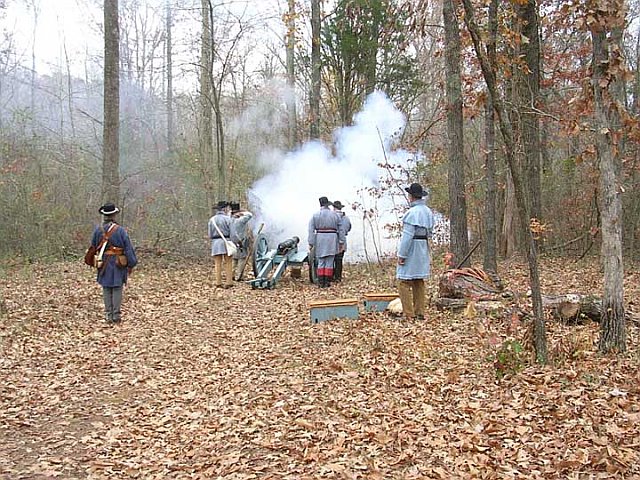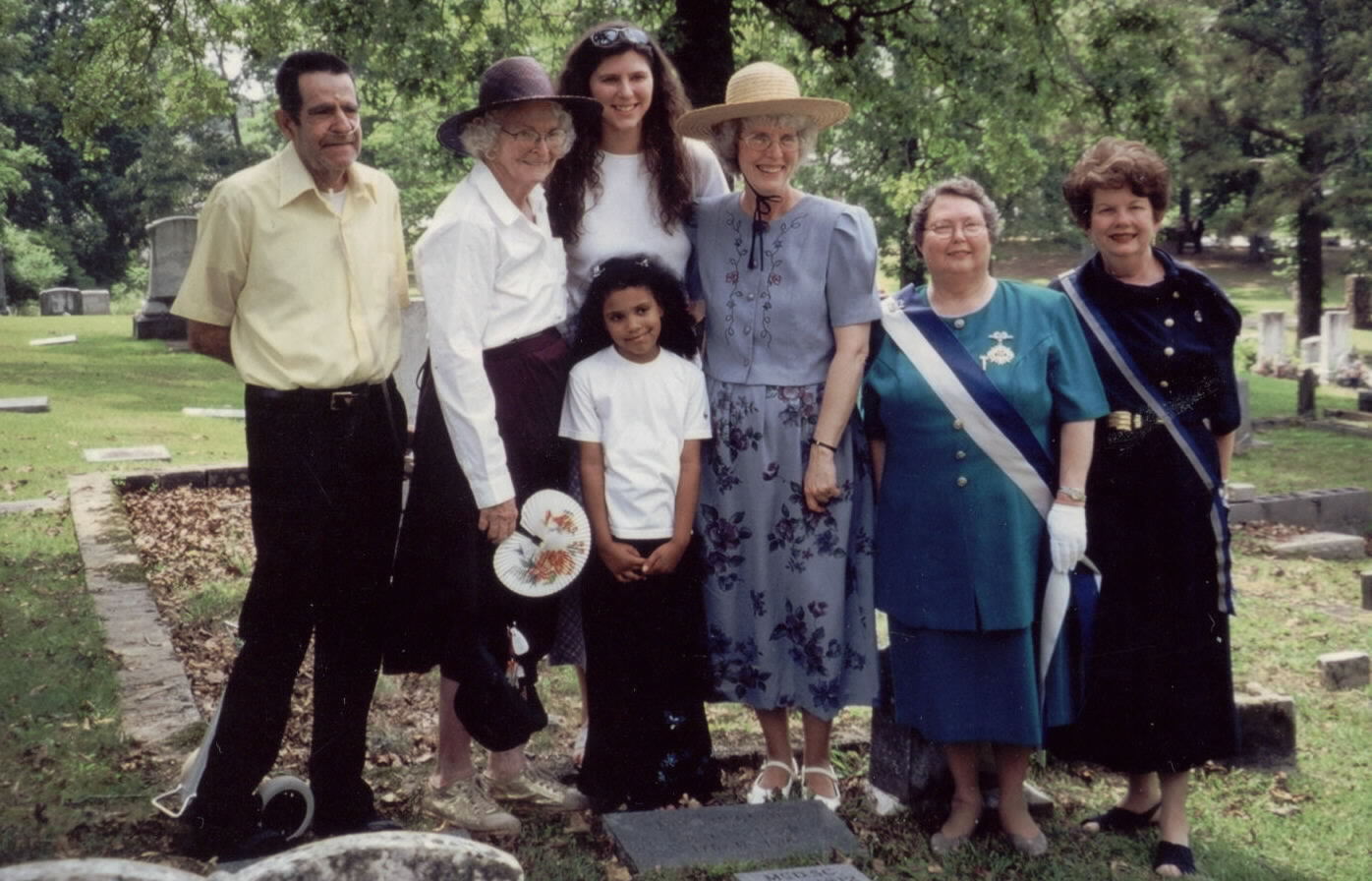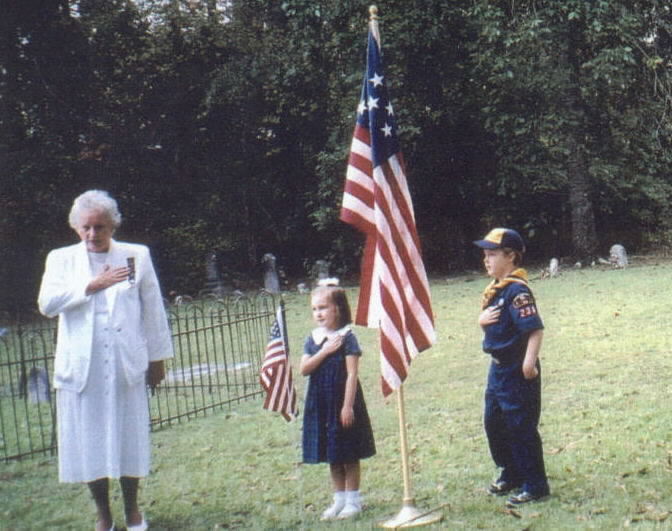
GRAVES MARKED AT BAILEY SPRINGS CEMETERY
December 08, 2007
Three War of 1812 Veterans are buried in the cemetery with
a fourth possible. The fourth veteran is a gentleman born in
Ireland who fought with General Andrew Jackson during the War
of 1812 and the Creek Indian Wars. The known veterans are:
Captain David Wasden Born Aug. 25, 1786 Died July 4, 1858
Corporal R. Mading (Madding) Born Oct. 29, 1785 Died Oct. 15, 1855
Corporal William Lane Duncan Born Feb. 14, 1779 Died Oct. 6, 1850
Captain David Wasden
Captain David Wasden was born in North Carolina and originally served as a
Sergeant in the 2nd Regiment of Tisdale’s North Carolina Militia from
September 1814 to March 1815. In this unit he served under Captain John Flowers
Company of drafted militia under the command of Lieutenant Emanuel Lloyd. He
was stationed initially at Beacon Island, NC and later at Newberry, NC. Sometime
in the winter of 1814, Captain Flowers was killed. After this Sgt. Wasden was
promoted to Captain and served in the 2nd Regiment of Bruton’s North
Carolina Militia. He commanded a detached Company of Militia drawn from the
county of Wayne, North Carolina stationed at New Berne, NC. After the War of
1812 he moved to Lawrence County, Alabama where he is recorded along with his
family in the 1850 Census. He was given a Land Grant – Certificate #
13.897 to purchase 40 acres in Lawrence County, Alabama. This Grant was dated
September 1, 1849 and signed by President Zachary Taylor. Captain Wasden’s
family included:
Wife – Dolly (moved to Sevier, Arkansas after Captain
Wasden’s death);
Sons – Augustus, James W., D.G.; Daughters – Arabla,
Dolly H.
David Wasden’s Obelisk reads:
In Memory
of
David Wasden
Born 23 Aug
1786
Died 4 July
1858
Captain in the War
of 1812
Corporal R. Mading (Madding)
Corporal R. Madding was born in Pittsylvania County, Virginia and was known
by either the name Rawley or Raleigh. He was the son of Thomas Madding who
served in the Continental Army during the Revolutionary War (9th Continental
Line – September to July 1777; Daniel Morgan’s Rifle Regiment
- July 1777 to December 1777; 4th Continental Light Dragoon Regiment – December
1777 to December 1780). Thomas was a veteran of Saratoga and Valley Forge.
Raleigh served as a Private in the 4th & 6th Regiment of the Virginia
Militia. In the 4th Regiment he served as a Private from January to April
1814. He served under the command of Captain John Quarles and Lieutenant
James Nance. During this time his unit was encamped at Camp Peach Orchard
in the rear of Fort Norfolk. He was later promoted to Corporal in the 6th
Regiment. He was listed under the 1820 Census of Greenville and Pittsylvania
Counties in Virginia. In May 1823 he and his siblings sold their inheritance
of 150 acres in Virginia and moved to Williamson County, Tennessee where
he bought a farm from his brother-in-law Obadiah Fitzgerald. His first wife
Sarah died in 1827 and he remarried Sally Bridgeman in 1828. He then moved
to Maury County - Columbia, Tennessee where he died in 1855. Raleigh also
had an older brother named Elisha who lived in Lawrence County, Alabama near
Captain Wasden. He named one of his son’s after his brother. Corporal
Madding had two wives and a total of 19 children. His family included:
1st Wife – Sarah Sally May (died 1827); Sons – Allison;
Gardner; Rawley A.; Elisha; Daughters – Martha; Mary; Sarah;
Ann; Francis
2nd Wife – Sally Bridgeman (died 1856); Sons – William;
Albert; John; David Franklin; George; Daughters – Lindsay
Louisa; Melissa Murlissy;
Matilda Jane; Susan; Emily
Raleigh Madding’s Headstone reads:
R. Mading
In Memory
who was born Oct
29th 1785 and died
Oct 15th 1855
Aged 69 years 11 mon
ths and 16 days
-----------<>-----------
The voyage of life’s at
an end
The mortal affliction
is past
The age that in heaven
they spend
For ever and ever shall
last
**Note: Poem on Corporal Madding’s Headstone comes from Hymnist Charles
Wesley’s song “Weep Not For a Brother Deceased” written in
1744. The poem is the last four verses of the song. Charles Wesley co-founded
the Methodist movement in England with his brother John Wesley.
Corporal William Lane Duncan
Corporal William Lane Duncan was born in North Carolina and was shown to be
living in Pontotoc County, Mississippi during the 1850 Census. He served
as a Private in the 4th Regiment of the Virginia Militia and later as a Corporal
in the 6th Regiment of the Virginia Militia (the same as Corporal Madding).
After his military service he moved to Georgia where he was married and had
three children. After this he volunteered to join the 1st Regiment of the
Mississippi Territory Volunteers. It is assumed this is how he came to live
in Pontotoc County, Mississippi. He was listed in the Census of 1850 of Pontotoc
County, Mississippi. He received a Land Grant – Certificate # 9344
to purchase 165 acres in Pontotoc County, Mississippi. This Grant was dated
November 16, 1840 and signed by President Martin Van Buren. On October 17,
1850 he received another Land Grant – Certificate # 22.1177 in Tishomingo
County, Mississippi for 160 acres signed by President Millard Fillmore. This
was 11 days after his death. It is believed he came to this area due to illness
and the nearby springs. Private Duncan’s family included:
Wife – Sarah; Sons – James W.,
William, Jeremiah
Wm. Duncan’s Headstone reads:
William Duncan
Born North Carolina
Feb 14, 1779
And for many years
a resident of
Pontotoc Co. Miss.
Died
Oct 6, 1850
|
| Alabama Daughters of 1812 at Marking |
HISTORY OF BAILEY
SPRING CEMETERY
The area just to the north-northwest
of Camp Westmoreland is known as Bailey Springs. It was at one
time
a resort in the 1800’s
due to the so-called curing agents of the mineral springs. Families
moved to the area due to these springs. Many famous people visited
the springs to enjoy their effects. Antebellum resorts and spas
offered wealthy individuals and families relaxation, social events
and advertised medical cures. Bailey Springs was one of the highest
regarded resorts in the South.
Jonathan Bailey came to Lauderdale County around 1820. He originally
purchased about 200 acres near Shoals Creek and later purchased
an additional 40 acres, which included the springs, from John
Hough. In 1843 “Mr. Bailey was
so afflicted with dyspepsia, that he was unable to visit distant mineral springs.” Thus,
he began to use his own springs and found himself almost well within 4 weeks.
From that point, the fame of the springs increased yearly. He eventually built
a resort to accommodate the many visitors. Mr. Michael Tuomey, the state of
Alabama’s first geologist visited the springs around this time. His examination
found them to be composed of carbonate iron, carbonate soda, chloride sodium,
carbonate potassa and sulfur. This was in part due to the geological structure
of the then called “Chaly Beat Springs”. Mr. James F. Sulzby, who
published "Historic Alabama Hotels and Resorts," said Bailey operated
his resort until his death in October 1857. Mr. Sulzby wrote that after Mr.
Bailey's death the resort was sold to Mr. A. G. Ellis. Ellis' daughter Virginia
married Dr. Henry A. Moody, who practiced medicine at Bailey Springs until
1888. Bailey Springs University for Women was founded in 1893, with Dr. Henry
A. Moody as president. Mr. Sulzby in his book said free tuition was offered
to 36 white females of Alabama between 14 and 24 years old. Charges for room,
heat, lights, washing and servants were not to exceed $13. The school was incorporated
Dec. 13, 1894, but almost immediately it suffered financially because of the
depression. There was only one known graduate from the school. In February
1899, the Alabama Legislature exempted Bailey Springs University from taxation
on condition that 36 scholarships are offered but continued financial difficulties
caused the school to close in 1900.
The resort attracted guests from throughout
the Southeast and even into the Ohio Valley. By the 1840’s the fame of the
resort spread and Bailey constructed a large hotel and large
ballroom. Water was even bottled and sent all over the South
and East. Guests would arrive at the Shoals by steamboat, train
or stagecoach. Families often moved to the area due to these
springs. Many famous people visited the springs to enjoy their
effects. Among them was Confederate General Nathan Bedford Forrest.
Former Alabama Governor and Supreme Court Chief Justice Henry
Watkins Collier died at Bailey Springs in 1853 while seeking
treatment for his illness. It was during the 1880’s that
Bailey Springs was the great resort for the wealthy classes.
It was known all over the nation as a pleasant place to visit.
Many references were made to the healing properties of the waters
of the many springs that flow at Bailey Springs. It is indicated
that its popularity in those early days probably drew interest
in its purchase from many people and companies.
In 1906 Bailey Springs was purchased by the
Interstate Club, an organization composed of some of the most
prominent and wealthy men in the United States. Among the partners
were President Theodore Roosevelt, Former President Grover
Cleveland, Senator Morgan of Alabama and many others. The property
was purchased for $25,000 and it was hoped that a Club House
could be built at Bailey Springs to cost not less than half
a million dollars. However, little was done with the property
and after a period of time it was sold off to local citizens
in the Florence area. The resort never regained its antebellum
status after the 1890’s.
Bailey Springs Cemetery Historical Certificate
As designated by Governor Bob Riley – 1st AHC Cemetery in Lauderdale
County
Located at the north end of Camp Westmoreland is the Bailey
Springs Cemetery (aka Camp Westmoreland or Chaly Beat Springs
Cemetery). Its location is noted as T2-S
R-10 on the Lauderdale County Map from the Historical Atlas of Alabama, Volume
2 - Cemeteries. GPS coordinates are: North 34 degrees 53 minutes 25.65 seconds
- West 87 degrees 34 minutes 29.09 seconds. On June 6, 2006, the Bailey Springs
Cemetery (or Camp Westmoreland Cemetery) was recognized by the Alabama Historical
Commission as the first cemetery in Lauderdale County to be placed on the Alabama
Historic Cemetery Register. First Class Scout Davis Faulkner of Troop 532 in
Helena, Alabama did research on the Cemetery and contacted the A.H.C. to receive
this designation. At the time of the designation there were only 65 other Cemeteries
in Alabama on the Register.
Most of the individuals buried at the cemetery are not known
since they were probably given wooden headstones. Most of those
interred in the Cemetery are thought to have been Bailey family
members or visitors to Bailey Springs. Some were there to take
in the curing agents of the mineral water. The cemetery was located
next to a one room non-denominational circuit church.
Markers
and Grave Dedications 1991-2003
Edmond Jones - Historical marker
placed by Cherokee Chapter Colonial Dames of the XVII Century
of Fort Payne and Alabama Society of Daughters of 1812 at the
Old Harmony Cemetery in Rainbow City, AL. Jones, who was five
years old in 1784, was the lone survivor of an Indian massacre
that occurred in that year, 1784.. In 1818 he returned to Rainbow
City as an adult and built a
Meeting House as a memorial to those who were killed by Indians
and deeded three acres for a cemetery.
John McDaniel. South Carolina militia
War of 1812. In Old Harmony Cemetery, Rainbow City, AL. McDaniel
served from Chester, SC.

Shown L-R Members of the John McDaniel
Family with
Mrs. Dee Wallace Ward, President National and E. Lamar Thomas,
AL Society President
John M. Dozier (1790-1870)
and his wife, Amy Jane Youngblood Dozier (1800-1876) were marked
on Sunday, October 13, 2002 by descendants of the Doziers with
the assistance of the Alabama Society Daughters of 1812 chaplain,
Mrs Herbert (Martha) Stanley at the Sardis Baptist Church Cemetery,
Union Springs, Alabama. The church and cemetery are on property
deeded by John and Amy Dozier. John Dozier served in the South
Carolina militia in regiments under the command of Carter, Youngblood
and Austin. He applied for a land bounty in Montgomery County,
AL on 20th. of March, 1855 and was granted 120 acres. The Sardis
Baptist Church, built in 1850, is on the Alabama Register of
Landmarks and Heritage Sites.
Pictured L to R: Mrs. Herbert Stanley,
US Daughters of 1812 Chaplain
with Dozier Descendants Hannah Fiqua and Monroe Heustess
in Cemetery of Sardis Baptist Church
Samuel Hosmer. The AS Daughters of
1812 marked his grave at the Big Hurricane Cemtery in Brookwood,
Tuscaloosa, County, AL Carole Thomas, Alabama Society president
led the Ritual assisted by Connie Grund. Also present was Bonnie
Glasgow, Columbia, SC, a member of the Andrew Jackson SC Society
Daughters of 1812, who is a descendant of Samuel Hosmer's. Sergeant
Hosmer served from the state of Maine and fought in the Battles
of Bangor and Hampden under Captain Amos Weston in Lt. Col. Andrew
Grant's 3rd. Regiment, 1st. Brigade 10 Division MA Militia. In
1819 Samuel and his wife Sukey migrated to Alabama with six of
their children. Samuel made his living as a farmer and blacksmith
and served as a Justice of Peace.

